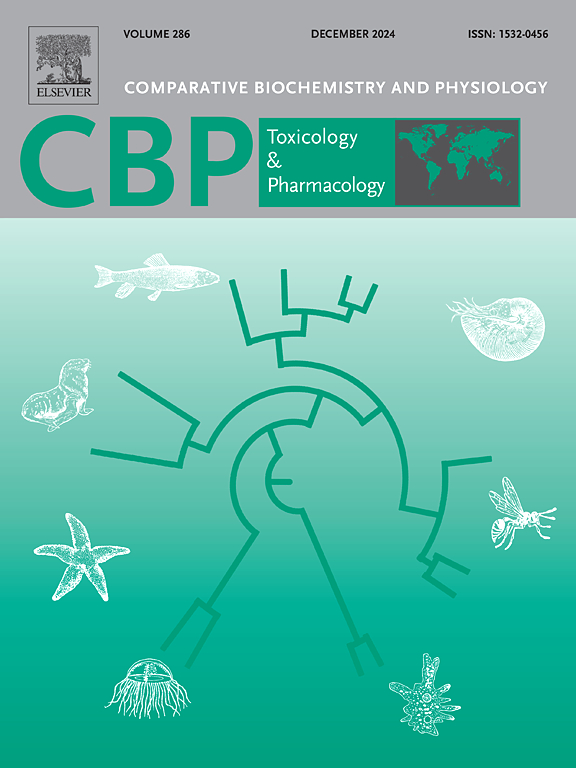The role of the ferroptosis pathway in the toxic mechanism of TCDD-induced liver damage in zebrafish
IF 3.9
3区 环境科学与生态学
Q2 BIOCHEMISTRY & MOLECULAR BIOLOGY
Comparative Biochemistry and Physiology C-toxicology & Pharmacology
Pub Date : 2025-04-24
DOI:10.1016/j.cbpc.2025.110213
引用次数: 0
Abstract
Dioxins, especially 2,3,7,8-Tetrachlorodibenzo-p-dioxin (TCDD) are harmful environmental pollutants, which is known to accumulate in humans and animals through ingestion, drinking water, and direct contact, leading to severe liver steatosis and cell death. This study used zebrafish as an experimental model to explore whether TCDD affects the liver via the ferroptosis pathway. The study examined microscopic and ultrastructural characteristics, oxidative stress-related indicators, iron content, and related gene and protein expression in zebrafish larvae liver cells. The results showed that TCDD exposure led to a decrease in the number of hepatocytes in zebrafish larvae. However, pretreatment with the ferroptosis inhibitor ferrostatin-1 (fer-1) alleviated these TCDD-induced changes. The transmission electron microscopy showed that TCDD exposure led to mitochondrial damage in the liver cells, an elevated iron content, a decrease in the level of the ferroptosis-related enzyme glutathione, increased alanine aminotransferase and malondialdehyde enzyme activities, and decreased glutathione peroxidase 4 protein levels. These effects were alleviated by the fer-1 pretreatment. At the gene level, TCDD exposure induced the expression of ferroptosis-related genes (tf, tfr, tfr1b, and fpn), inflammatory factor-related genes (NF-kB, ptgs2a, and ptgs2b), and lipid degeneration and autophagy genes (atg5, ncoa4, and acox1), and inhibited the expression of oxidative stress-related genes (gpx4, slc7a11, and nrf2). The fer-1 pretreatment counteracted these gene expression changes induced by TCDD. These findings indicate that TCDD-induced liver fatty degeneration and cell death are closely related to the ferroptosis pathway.

铁下垂途径在tcdd诱导斑马鱼肝损伤毒性机制中的作用
二恶英,特别是2,3,7,8-四氯二苯并-对二恶英(TCDD)是有害的环境污染物,已知可通过摄入、饮用水和直接接触在人和动物体内积累,导致严重的肝脏脂肪变性和细胞死亡。本研究以斑马鱼为实验模型,探讨TCDD是否通过铁下垂途径影响肝脏。本研究检测了斑马鱼幼鱼肝细胞的显微和超微结构特征、氧化应激相关指标、铁含量及相关基因和蛋白表达。结果表明,TCDD暴露导致斑马鱼幼虫肝细胞数量减少。然而,用铁下垂抑制剂铁抑素-1 (fer-1)预处理可以减轻这些tcdd诱导的变化。透射电镜显示,TCDD暴露导致肝细胞线粒体损伤,铁含量升高,与铁中毒相关的酶谷胱甘肽水平降低,丙氨酸转氨酶和丙二醛酶活性升高,谷胱甘肽过氧化物酶4蛋白水平降低。经fe -1预处理后,上述影响有所缓解。在基因水平上,TCDD暴露诱导了铁中毒相关基因(tf、tfr、tfr1b、fpn)、炎症因子相关基因(NF-kB、ptgs2a、ptgs2b)、脂质变性和自噬基因(atg5、ncoa4、acox1)的表达,抑制了氧化应激相关基因(gpx4、slc7a11、nrf2)的表达。fe -1预处理可抵消TCDD诱导的这些基因表达变化。这些结果表明,tcdd诱导的肝脏脂肪变性和细胞死亡与铁下垂途径密切相关。
本文章由计算机程序翻译,如有差异,请以英文原文为准。
求助全文
约1分钟内获得全文
求助全文
来源期刊
CiteScore
7.50
自引率
5.10%
发文量
206
审稿时长
30 days
期刊介绍:
Part C: Toxicology and Pharmacology. This journal is concerned with chemical and drug action at different levels of organization, biotransformation of xenobiotics, mechanisms of toxicity, including reactive oxygen species and carcinogenesis, endocrine disruptors, natural products chemistry, and signal transduction with a molecular approach to these fields.

 求助内容:
求助内容: 应助结果提醒方式:
应助结果提醒方式:


